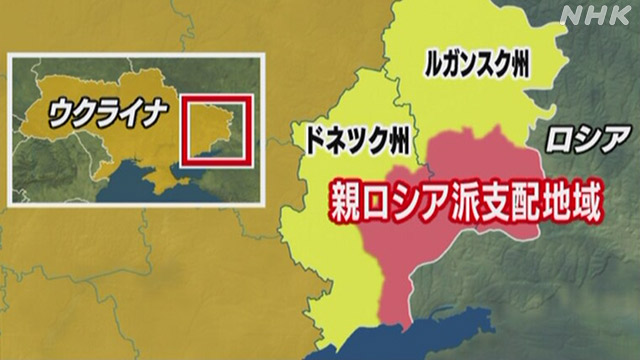Russian President Vladimir Putin unilaterally acknowledged the independence of the region virtually controlled by pro-Russian factions in eastern Ukraine, and ordered the dispatch of Russian troops to the site under the pretext of "peacekeeping."
□ Why did Russia decide to unilaterally approve independence?
□ Are you heading for a military invasion in the future?
□ What kind of region is eastern Ukraine?
I will explain the tense situation.
What is eastern Ukraine?
Both Donetsk and parts of Lugansk in eastern Ukraine border Russia and are occupied by pro-Russian militants.
It is a region that has close ties to Russia both historically and economically, and has many inhabitants whose native language is Russian.
With coal mines and iron ore mines developed during the Soviet era, the steel industry flourished against the backdrop of abundant resources, making it one of Ukraine's leading industrial areas.
Sporadic fighting between pro-Russian armed groups backed by Russia since 2014 and Ukrainian government forces has been one of the causes of the conflict between Russia and Ukraine.
Occupy one after another, such as the building of the state government building
In April 2014, shortly after Russia unilaterally annexed Crimea in southern Ukraine, pro-Russian militants rushed to state government buildings and security agency buildings and occupied them one after another.
After that, he unilaterally announced his independence from Ukraine.
So far, more than 14,000 people have died
In response to this, the Ukrainian government dispatched troops to embark on forced exclusion, but it developed into a situation in which many people died due to violent clashes with armed groups in various parts of the country.
A ceasefire agreement called the "Minsk Agreement" was signed in September 2014 and February 2015 with the mediation of France and Germany in an attempt to resolve the dispute between government forces and pro-Russian armed groups. Sporadic battles continued after that.
According to OHCHR = Office of the United Nations High Commissioner for Human Rights, more than 14,000 people have died on both sides so far.
Eight years of conflict have caused enormous damage to infrastructure such as water and heating facilities that are essential to life, and so far 1.5 million people have been forced to evacuate the area.
[Explanation] One-sided national recognition What is Russia's aim?
The situation is becoming even more tense with Russia's unilateral approval of an independent state, but why did Russia decide to approve it and what is the possibility of a military invasion?
Gonpei, the director of the Moscow bureau, will explain.
1. Why did you decide to approve the state?
One-sided approval as a state means that Russia will take control of some parts of eastern Ukraine.
President Putin has long regarded Ukraine as his sphere of influence.
And this time, it seems that we have to unilaterally approve it.
Russia has demanded that Ukraine not expand NATO, saying that its accession to NATO = North Atlantic Treaty Organization is "a line that must not be crossed", but Europe and the United States do not respond to this and conversely provide military weapons to Ukraine. Support has been strengthened.
The pro-Russian faction said, "Ukrainian government forces will recapture it by force," and President Putin, who received state approval and a request for military support, responded.
However, one-sided state approval will lead Russia to dismiss the ceasefire agreement that has been approaching the Ukrainian government.
With the intention of tightening sanctions from the West, President Putin has chosen to make sure that eastern Ukraine is under influence, following the 2014 Crimean crisis.
2. To dispatch "peacekeeping" troops What is the possibility of invasion?
Russia's position is that there is no "military invasion," but President Putin has instructed the Ministry of Defense to send Russian troops to the field in the name of "peacekeeping."
It may lead to the military presence by Russia.
Russia still has a large army around the Ukrainian border.
In Belarus, which borders the northern part of Ukraine, troops are stationed and pressure is maintained even after the 20th, when the joint military exercise was scheduled to end.
First of all, the focus is on when and how large the Russian army will deploy.
If deployed, it is necessary to determine if it will lead to a more permanent stay.
The question is how far Japan and other Western countries can unite to protect Ukraine's sovereignty and territorial integrity.

